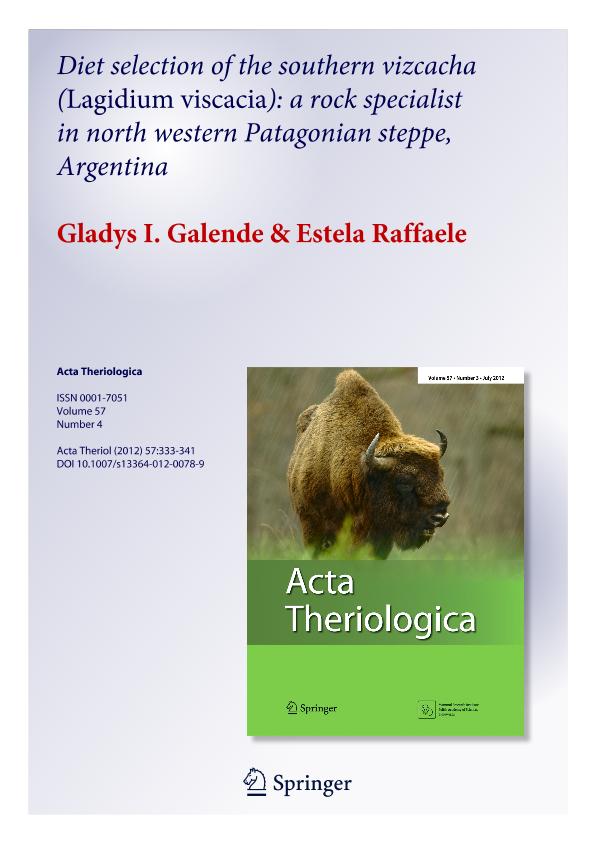Mostrar el registro sencillo del ítem
dc.contributor.author
Galende, Gladys I.
dc.contributor.author
Raffaele, Estela

dc.date.available
2019-04-08T20:47:10Z
dc.date.issued
2012-10
dc.identifier.citation
Galende, Gladys I.; Raffaele, Estela; Diet selection of the southern vizcacha (Lagidium viscacia): A rock specialist in north western Patagonian steppe, Argentina; Polish Academy of Sciences; Acta Theriologica; 57; 4; 10-2012; 333-341
dc.identifier.issn
0001-7051
dc.identifier.uri
http://hdl.handle.net/11336/73501
dc.description.abstract
The southern vizcacha (Lagidium viscacia) is a rock specialist that inhabits small colonies in isolated rocky outcrops of northwestern Patagonia. This study analyzes its diet selection in relation to food availability, establishes the degree of dietary specialization, and discusses the potential competition with exotic herbivores. Diet composition and food availability were determined in summer and winter in eight rocky outcrops by microhistological analysis of fecal pellets, and food availability was estimated by the Braun Blanquet cover abundance scale. Vegetation cover differences were detected by using a random analysis of variance (ANOVA) factorial block design, and dietary preferences were determined by the confidence interval of Bonferroni. The southern vizcacha showed a specialized feeding behavior despite the consumption of a wide variety of items. Their diet was concentrated on a few types of food, mainly grasses, and the trophic niche was narrow and without seasonal variations. In winter, when food was scarce and of lower quality than summer, diet was dominated by Stipa speciosa, suggesting a selection according to the selective quality hypothesis. Our results (narrow trophic niche, restricted activity near rocky outcrops, and a diet with high proportions of low-quality grasses) showed that the vizcacha is an obligatory dietary specialist, and these characteristics made it highly vulnerable to changes in food availability. In this scenario, overgrazing caused by alien species with similar diets, as the European hare and livestock, could negatively affect their colonies.
dc.format
application/pdf
dc.language.iso
eng
dc.publisher
Polish Academy of Sciences

dc.rights
info:eu-repo/semantics/openAccess
dc.rights.uri
https://creativecommons.org/licenses/by-nc-sa/2.5/ar/
dc.subject
Food Quality Hypothesis
dc.subject
Rocky Outcrops
dc.subject
Selectivity
dc.subject
Trophic Niche
dc.subject.classification
Otras Ciencias Biológicas

dc.subject.classification
Ciencias Biológicas

dc.subject.classification
CIENCIAS NATURALES Y EXACTAS

dc.title
Diet selection of the southern vizcacha (Lagidium viscacia): A rock specialist in north western Patagonian steppe, Argentina
dc.type
info:eu-repo/semantics/article
dc.type
info:ar-repo/semantics/artículo
dc.type
info:eu-repo/semantics/publishedVersion
dc.date.updated
2019-03-08T16:45:15Z
dc.identifier.eissn
2190-3743
dc.journal.volume
57
dc.journal.number
4
dc.journal.pagination
333-341
dc.journal.pais
Polonia

dc.journal.ciudad
Bialowieza
dc.description.fil
Fil: Galende, Gladys I.. Universidad Nacional del Comahue. Centro Regional Universidad Bariloche. Departamento de Zoología; Argentina
dc.description.fil
Fil: Raffaele, Estela. Consejo Nacional de Investigaciones Científicas y Técnicas. Centro Científico Tecnológico Conicet - Patagonia Norte. Instituto de Investigaciones en Biodiversidad y Medioambiente. Universidad Nacional del Comahue. Centro Regional Universidad Bariloche. Instituto de Investigaciones en Biodiversidad y Medioambiente; Argentina. Universidad Nacional del Comahue. Centro Regional Universitario Bariloche. Laboratorio de Ecotono; Argentina
dc.journal.title
Acta Theriologica

dc.relation.alternativeid
info:eu-repo/semantics/altIdentifier/doi/http://dx.doi.org/10.1007/s13364-012-0078-9
dc.relation.alternativeid
info:eu-repo/semantics/altIdentifier/url/https://link.springer.com/article/10.1007%2Fs13364-012-0078-9
Archivos asociados
